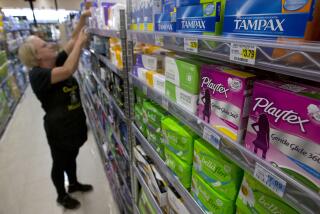They’re in a Battle for the Bottom in Nationwide Diaper Wars : Environment: Disposables are a billion-dollar business, and mothers love them. But they create a trash nightmare.
NEW YORK — It was test-marketed in 1961 in--where else?--Peoria, Ill.
And, oh, how well it played!
In the years since, the disposable diaper has been improved: There are elasticized leg bands, gels, super absorbency, and anatomically efficient “his” and “hers” designs.
It has become a $3.5-billion-a-year industry, and 85% of American mothers use them.
In recent years, the disposable diaper has become a prime target of angry environmentalists who consider it the very symbol of the ills of a throwaway society. The problem is what to do with it once it has done its job. Throwaway diapers are piling up in the waste stream.
The way a mother covers her baby’s bottom has become a subject of hot debate in statehouses and city halls. The issue has generated piles of reports and pamphlets. Who would have thought the manufacturers of disposable diapers would have to go to such lengths to defend such a wonder product?
Bills that would ban, restrict or tax sales of disposable diapers are before the legislatures of a dozen states.
Meanwhile the controversy has breathed new life into the diaper service business, and it could prove a boon to corn farmers.
Studies show that although disposable diapers are only about 2% of the nation’s trash, they last 500 years in a landfill. One proposed solution is a more-expensive biodegradable diaper, and that’s where the corn farmers come in.
Jeanne Wirka, a solid-waste-reduction expert with the Environmental Action Foundation, said the disposable diaper is the largest single one-use product for which there is a readily available alternative--cloth diapers.
But the convenience factor is extraordinary. Many day-care centers, for example, will not accept youngsters in cloth diapers.
And, if everyone switched to cloth tomorrow, there would be chaos. There are not enough cloth diapers or cloth diaper services in the country to accommodate them. In environmentally hip Washington, D.C., 400 names are on the waiting list for the one diaper service in town.
The National Assn. of Diaper Services, after years of decline, reported a 38% increase in business last year and a 13% rise the year before. The disposable diaper makers, however, say they see no blip yet on their sales screen.
The debate has produced strange bedfellows. The six most active environmental groups and Procter & Gamble Co. and Kimberly-Clark Corp., the disposable diaper manufacturers who control more than 75% of the market, agree that biodegradable diapers are not the answer.
Last December, environmentalists called for a boycott of degradable diapers, saying their use merely assuages the consumer’s conscience. Biodegradable diapers don’t decompose in landfills because there is not enough moisture or oxygen in a dump, they said.
Taking an opposing view is the National Assn. of Corn Growers, based in St. Louis. Cornstarch is used in the degradables and this could open up a market of 150 million to 300 million bushels a year for the nation’s corn farmers, spokesman Tim Draeger said.
So far, the only state to enact legislation has been Nebraska, which passed a law last session requiring the use of biodegradables by 1993. Nebraska, it might be noted, is the nation’s third-largest corn-producing state, just behind Iowa and Illinois.
Draeger argues that if the biodegradable diaper technology were improved, it would mean America would be less dependent on foreign oil.
“We are in the infancy of this technology,” he said. “We are at the Model T level. We have to learn to walk before we can run.”
Wirka said that is plain silly because the amount of “foreign oil” in diapers is negligible and the so-called degradables also contain some oil.
Cincinnati-based Procter & Gamble, with a $1.65-billion slice of the disposable pie--compared to Kimberly-Clark’s $840 million--has taken a much higher profile in its fight to keep baby’s bottom in Pampers and Luvs.
Although close-mouthed about how much it is spending on the diaper wars, P & G is sponsoring two well-publicized projects, one in Seattle demonstrating that plastic diapers can be recycled and another in St. Cloud, Minn., to show that diapers can be composted. The Seattle project is reputed to be a $500,000 venture.
“If you could throw that kind of money at every segment of the trash problem in America, we wouldn’t have a trash problem,” said Jeffrey Tryens of the Council for Policy Alternatives, a Washington-based environmental group. “It’s just good public relations for Procter & Gamble.”
Wirka, however, thinks the St. Cloud project may have some merit, although, she said: “That recycling project is just bogus.
“Procter & Gamble is in a difficult position. They are always the target here and they are applying their corporate good guy image on something that is economically very dubious. I’m more willing to say that the composting project is a more fruitful use of their resources.”
P&G;, it should be noted, has been a leader in recycling plastic bottles for its products, selling refills for the same plastic bottle and marketing concentrates in smaller bottles where the consumer just needs to add water. Its soaps are also biodegradable.
Since the diaper wars started making the nightly news shows, politicians have gotten bolder. Tryens said he called a meeting about a year ago, inviting legislators, lobbyists, environmentalists and others concerned about the issue.
“At that time, nobody even considered discussing a statewide ban,” he said. “The feeling was that no respectable politician would even propose such legislation and that it just wouldn’t fly.”
But one year later, the state of Vermont is proposing just such legislation as part of a much larger environmental bill. If passed, no disposable diapers would be sold in Vermont after 1993.
Nancy Alexander of New Haven, Conn., is one who’s profiting by it all. She started her own cloth diaper service in January and said clients are flocking to her door.
“I’ve always wanted to go into my own business and this just sort of fell into my lap,” she said. “What’s more is that all of my clients treat me like I’m some kind of a hero.”
One of her clients with a newborn baby said her 4-year-old was watching her change the baby with a disposable diaper and had a quizzical look on her face.
“What is it?” asked the mother.
“Why don’t they invent a diaper you could just wash and use over and over?” asked the child.
Disposable Diapers How Single-use Diapers Work Absorbent layer-filled with wood-pulp or acrylic polymer crystals that can absorb up to 80 times their weight in moisture. Tape Elastic gathers-Fit snug around baby’s legs to prevent leakage Plastic Liner-Keeps moisture inside diaper Liner-Holds absorbent layer in place and prevents moisture from flowing back to baby’s skin Disposable diapers are a product with a possible 15-minute life span which will last 500 years in a landfill. More expensive degradable diapers may hinder future plastic-recycling efforts. Disposable diapers make up 2% of the municipal solid waste we produce. The Diaper Market Kimberly-Clark (Huggies): 30% Procter & Gamble (Pampers): 25% Procter & Gamble (Luvs): 24% Weyehaeuser (private label): 10% Other: 11% Solid Waste and The Diaper Estimated amounts of the trash we produce, based on waste characterization studies, acknowledging single-use diapers contain overlapping categories of waste. Diapers: 2.0% Paper: 36% Plastic: 7.6% Yard trimmings: 20% Food: 8.7% Glass: 8.4% Metal: 8.9% Other: 8.4% Source: Wertheim Schroder & Co., Corn Growers Assn., The Garbage Project, University of Arizona
More to Read
Inside the business of entertainment
The Wide Shot brings you news, analysis and insights on everything from streaming wars to production — and what it all means for the future.
You may occasionally receive promotional content from the Los Angeles Times.










